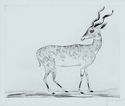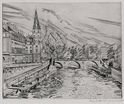
19th, 20th & 21st Century Fine Prints
707-546-7352 · fax 707-546-7924 · web: www.annexgalleries.com · email: artannex@aol.com
Joseph Hecht Biography
Joseph Hecht
Polish
1891–1951
Biography
Joseph Hecht, painter and printmaker, was born on December 14, 1891, in Lodz, Poland. With his family’s support he studied at the Académie Beaux-Arts in Krakow between 1909 and 1914, where he was awarded annual prizes.
Hecht traveled throughout Europe until the beginning of WWI when he went to live in Norway. He remained in Norway until 1919, living in the coastal town Asker near Oslo, and during those years he painted and worked in drypoint, engraving, and woodcut. Once the war ended, Hecht traveled to Italy and two years later to Paris where he connected with other artists and was assigned a studio at the Hotel Villa Falguière.
In 1920, Hecht gained membership in the Salon d’Automne and later in the Salon des Indépendents. The year 1926 proved to be pivotal for Hecht. He illustrated Blaise Cendrars’ L’Eubage aux antipodes de l’unité with five engravings and a solo exhibition of his work was presented at the gallery of Berthe Weill. He also published a portfolio of six prints, l’Arche de Noë, with a forward by Symbolist Gustave Kahn, which was the basis for his solo exhibition at the Galerie le Nouvel Essor. That same year Hecht met Stanley William Hayter whom he instructed in the art of engraving and the technicalities of printmaking. He also encouraged Hayter to open a cooperative printmaking studio, which became Atelier 17.
Hecht, with the camaraderie of artists such as Pierre Guastalla, André Jacquemin and Louis Jospeph Soulas, co-founded an association of artists named La Jeune Gravure Contemporaine (The Young Contemporary Printmakers) in 1930, and exhibited with the association between 1931 and 1936. Hecht traveled to San Francisco in 1933 for an exhibition of his work and upon his return he published his portfolio of ten engravings, Paris. In 1937, Hecht was awarded two gold medals at the Exposition Universelle in Paris. The following year he published another portfolio, this consisting of ten engraving, entitled Nouveaux Croquis d’Animaux.
In 1941, as conditions in Europe became more difficult, Hecht, who was Jewish, fled Paris and spent the war years working as an agricultural laborer in the Savoie region of France. He returned to Paris in 1944 to find his studio untouched and he slowly returned to printmaking. Upon Hayter's return to France in 1946, he contacted Hecht and they collaborated on the burin engraving La Noyée. Hecht invented a new relief printing process and, in 1950, he published Quelques Aventures de Maître Renart, a portfolio of fourteen engravings.
In 1951, Hecht produced his final five engravings. It was during this that he suffered a heart attack and died in his studio on July 19.
“He possessed an extreme sensitivity to all the qualities of a line - rigidity, flexibility, resilience - and saw the character of life in the line itself, not the description of life by means of the line. An examination of the prints of Hecht...will show that there is not a limp or dead line in them.”- S.W. Hayter







